To Kill a Mockingbird: Exploring Themes of Racism and Sexism
VerifiedAdded on 2020/05/03
|5
|1437
|112
Essay
AI Summary
This essay provides a detailed analysis of the prominent themes of racism and sexism in Harper Lee's novel, 'To Kill a Mockingbird.' It argues that these themes are central to the narrative, illustrating racial injustice through the trial of Tom Robinson and the prejudiced views of the Maycomb society. The essay explores how the novel highlights the objectification of Black individuals and the pervasive racial inequality. Furthermore, it examines the theme of sexism, focusing on the limitations and expectations placed upon female characters like Scout, who challenges societal norms. The essay references the character of Aunt Alexandra and Miss Maudie to provide a better understanding of the sexism that is present throughout the novel. The essay highlights how the novel critiques patriarchal values and restricts women's freedom. The essay concludes by emphasizing the enduring impact of the novel's treatment of racial and gender inequality, and the enduring image of Atticus Finch as a symbol of racial heroism.
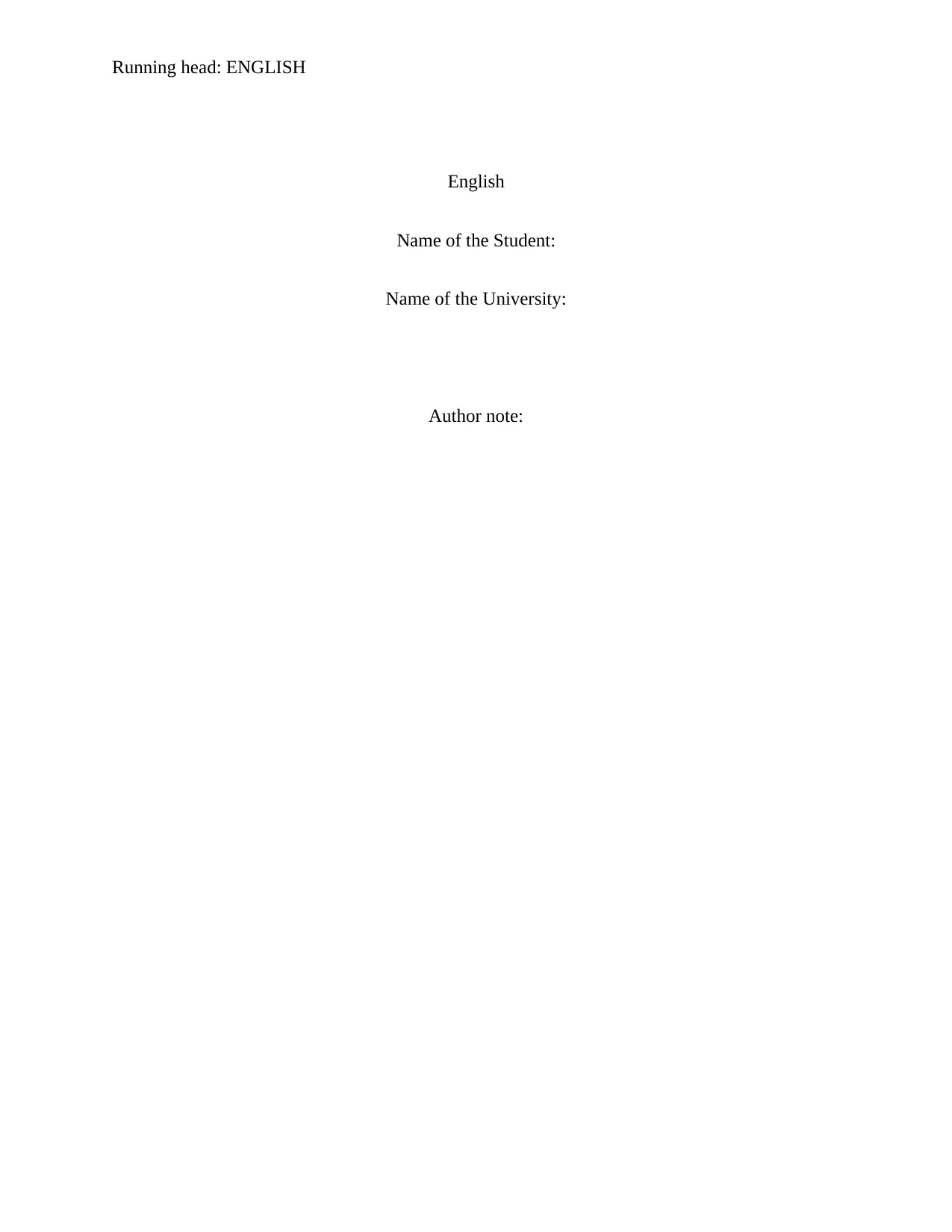
Running head: ENGLISH
English
Name of the Student:
Name of the University:
Author note:
English
Name of the Student:
Name of the University:
Author note:
Paraphrase This Document
Need a fresh take? Get an instant paraphrase of this document with our AI Paraphraser
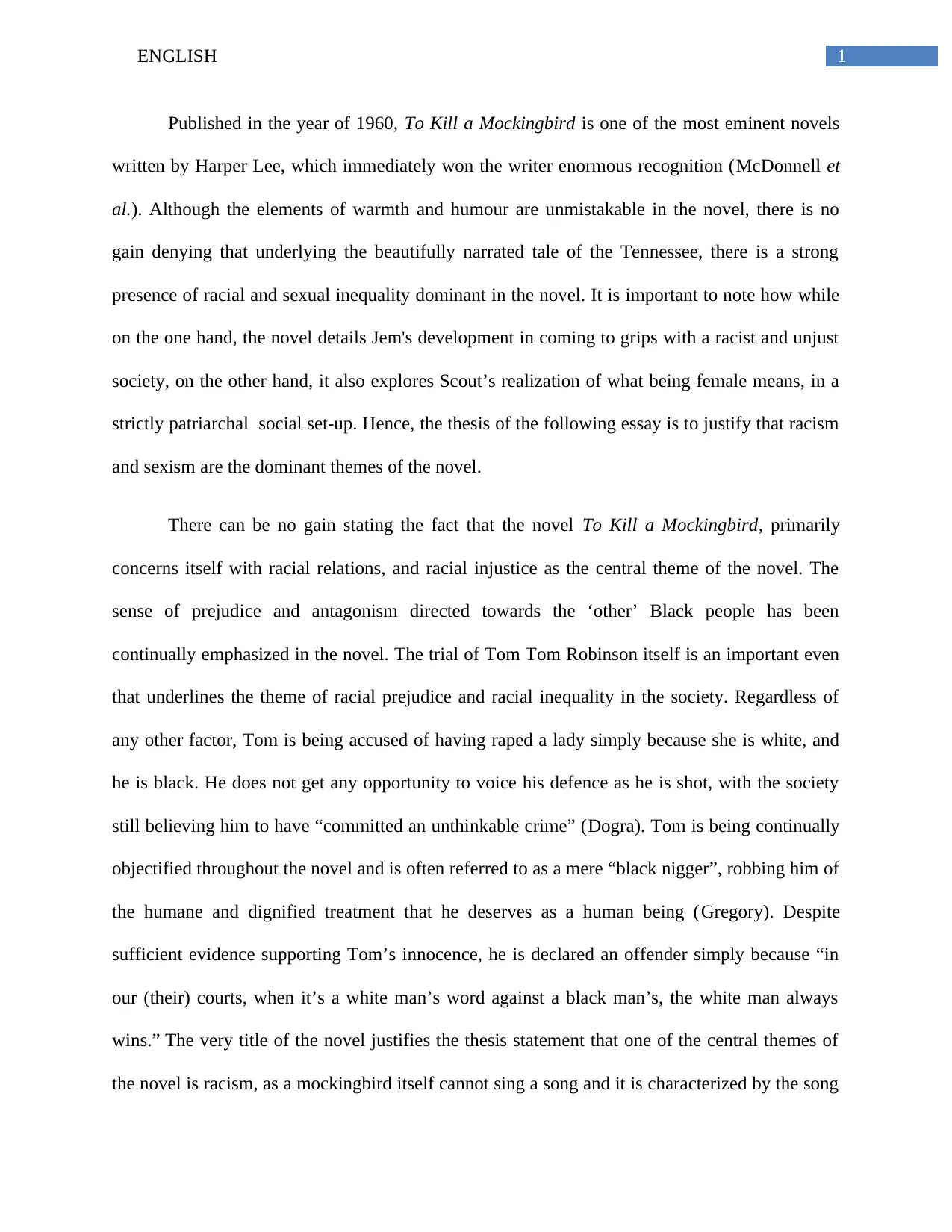
1ENGLISH
Published in the year of 1960, To Kill a Mockingbird is one of the most eminent novels
written by Harper Lee, which immediately won the writer enormous recognition (McDonnell et
al.). Although the elements of warmth and humour are unmistakable in the novel, there is no
gain denying that underlying the beautifully narrated tale of the Tennessee, there is a strong
presence of racial and sexual inequality dominant in the novel. It is important to note how while
on the one hand, the novel details Jem's development in coming to grips with a racist and unjust
society, on the other hand, it also explores Scout’s realization of what being female means, in a
strictly patriarchal social set-up. Hence, the thesis of the following essay is to justify that racism
and sexism are the dominant themes of the novel.
There can be no gain stating the fact that the novel To Kill a Mockingbird, primarily
concerns itself with racial relations, and racial injustice as the central theme of the novel. The
sense of prejudice and antagonism directed towards the ‘other’ Black people has been
continually emphasized in the novel. The trial of Tom Tom Robinson itself is an important even
that underlines the theme of racial prejudice and racial inequality in the society. Regardless of
any other factor, Tom is being accused of having raped a lady simply because she is white, and
he is black. He does not get any opportunity to voice his defence as he is shot, with the society
still believing him to have “committed an unthinkable crime” (Dogra). Tom is being continually
objectified throughout the novel and is often referred to as a mere “black nigger”, robbing him of
the humane and dignified treatment that he deserves as a human being (Gregory). Despite
sufficient evidence supporting Tom’s innocence, he is declared an offender simply because “in
our (their) courts, when it’s a white man’s word against a black man’s, the white man always
wins.” The very title of the novel justifies the thesis statement that one of the central themes of
the novel is racism, as a mockingbird itself cannot sing a song and it is characterized by the song
Published in the year of 1960, To Kill a Mockingbird is one of the most eminent novels
written by Harper Lee, which immediately won the writer enormous recognition (McDonnell et
al.). Although the elements of warmth and humour are unmistakable in the novel, there is no
gain denying that underlying the beautifully narrated tale of the Tennessee, there is a strong
presence of racial and sexual inequality dominant in the novel. It is important to note how while
on the one hand, the novel details Jem's development in coming to grips with a racist and unjust
society, on the other hand, it also explores Scout’s realization of what being female means, in a
strictly patriarchal social set-up. Hence, the thesis of the following essay is to justify that racism
and sexism are the dominant themes of the novel.
There can be no gain stating the fact that the novel To Kill a Mockingbird, primarily
concerns itself with racial relations, and racial injustice as the central theme of the novel. The
sense of prejudice and antagonism directed towards the ‘other’ Black people has been
continually emphasized in the novel. The trial of Tom Tom Robinson itself is an important even
that underlines the theme of racial prejudice and racial inequality in the society. Regardless of
any other factor, Tom is being accused of having raped a lady simply because she is white, and
he is black. He does not get any opportunity to voice his defence as he is shot, with the society
still believing him to have “committed an unthinkable crime” (Dogra). Tom is being continually
objectified throughout the novel and is often referred to as a mere “black nigger”, robbing him of
the humane and dignified treatment that he deserves as a human being (Gregory). Despite
sufficient evidence supporting Tom’s innocence, he is declared an offender simply because “in
our (their) courts, when it’s a white man’s word against a black man’s, the white man always
wins.” The very title of the novel justifies the thesis statement that one of the central themes of
the novel is racism, as a mockingbird itself cannot sing a song and it is characterized by the song
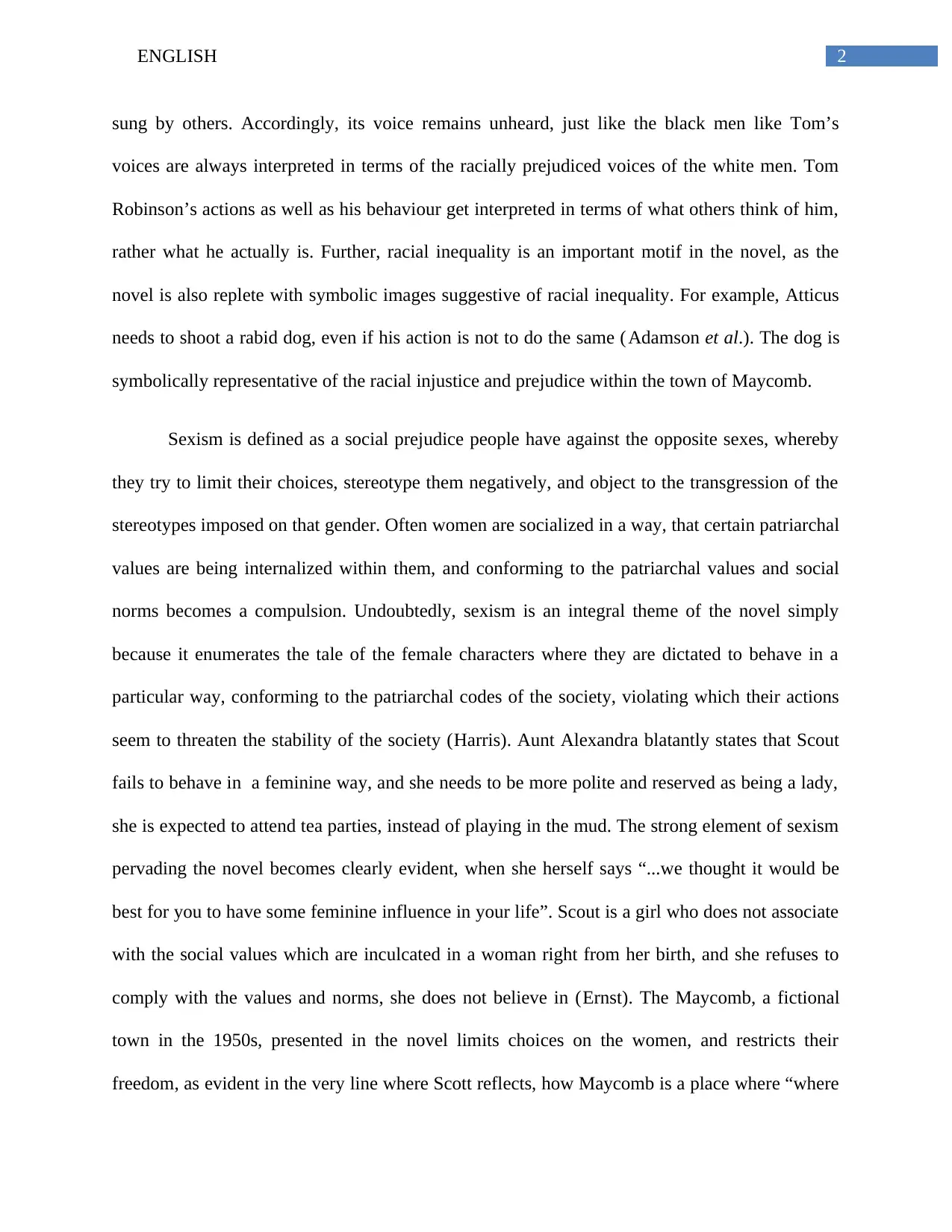
2ENGLISH
sung by others. Accordingly, its voice remains unheard, just like the black men like Tom’s
voices are always interpreted in terms of the racially prejudiced voices of the white men. Tom
Robinson’s actions as well as his behaviour get interpreted in terms of what others think of him,
rather what he actually is. Further, racial inequality is an important motif in the novel, as the
novel is also replete with symbolic images suggestive of racial inequality. For example, Atticus
needs to shoot a rabid dog, even if his action is not to do the same (Adamson et al.). The dog is
symbolically representative of the racial injustice and prejudice within the town of Maycomb.
Sexism is defined as a social prejudice people have against the opposite sexes, whereby
they try to limit their choices, stereotype them negatively, and object to the transgression of the
stereotypes imposed on that gender. Often women are socialized in a way, that certain patriarchal
values are being internalized within them, and conforming to the patriarchal values and social
norms becomes a compulsion. Undoubtedly, sexism is an integral theme of the novel simply
because it enumerates the tale of the female characters where they are dictated to behave in a
particular way, conforming to the patriarchal codes of the society, violating which their actions
seem to threaten the stability of the society (Harris). Aunt Alexandra blatantly states that Scout
fails to behave in a feminine way, and she needs to be more polite and reserved as being a lady,
she is expected to attend tea parties, instead of playing in the mud. The strong element of sexism
pervading the novel becomes clearly evident, when she herself says “...we thought it would be
best for you to have some feminine influence in your life”. Scout is a girl who does not associate
with the social values which are inculcated in a woman right from her birth, and she refuses to
comply with the values and norms, she does not believe in (Ernst). The Maycomb, a fictional
town in the 1950s, presented in the novel limits choices on the women, and restricts their
freedom, as evident in the very line where Scott reflects, how Maycomb is a place where “where
sung by others. Accordingly, its voice remains unheard, just like the black men like Tom’s
voices are always interpreted in terms of the racially prejudiced voices of the white men. Tom
Robinson’s actions as well as his behaviour get interpreted in terms of what others think of him,
rather what he actually is. Further, racial inequality is an important motif in the novel, as the
novel is also replete with symbolic images suggestive of racial inequality. For example, Atticus
needs to shoot a rabid dog, even if his action is not to do the same (Adamson et al.). The dog is
symbolically representative of the racial injustice and prejudice within the town of Maycomb.
Sexism is defined as a social prejudice people have against the opposite sexes, whereby
they try to limit their choices, stereotype them negatively, and object to the transgression of the
stereotypes imposed on that gender. Often women are socialized in a way, that certain patriarchal
values are being internalized within them, and conforming to the patriarchal values and social
norms becomes a compulsion. Undoubtedly, sexism is an integral theme of the novel simply
because it enumerates the tale of the female characters where they are dictated to behave in a
particular way, conforming to the patriarchal codes of the society, violating which their actions
seem to threaten the stability of the society (Harris). Aunt Alexandra blatantly states that Scout
fails to behave in a feminine way, and she needs to be more polite and reserved as being a lady,
she is expected to attend tea parties, instead of playing in the mud. The strong element of sexism
pervading the novel becomes clearly evident, when she herself says “...we thought it would be
best for you to have some feminine influence in your life”. Scout is a girl who does not associate
with the social values which are inculcated in a woman right from her birth, and she refuses to
comply with the values and norms, she does not believe in (Ernst). The Maycomb, a fictional
town in the 1950s, presented in the novel limits choices on the women, and restricts their
freedom, as evident in the very line where Scott reflects, how Maycomb is a place where “where
⊘ This is a preview!⊘
Do you want full access?
Subscribe today to unlock all pages.

Trusted by 1+ million students worldwide
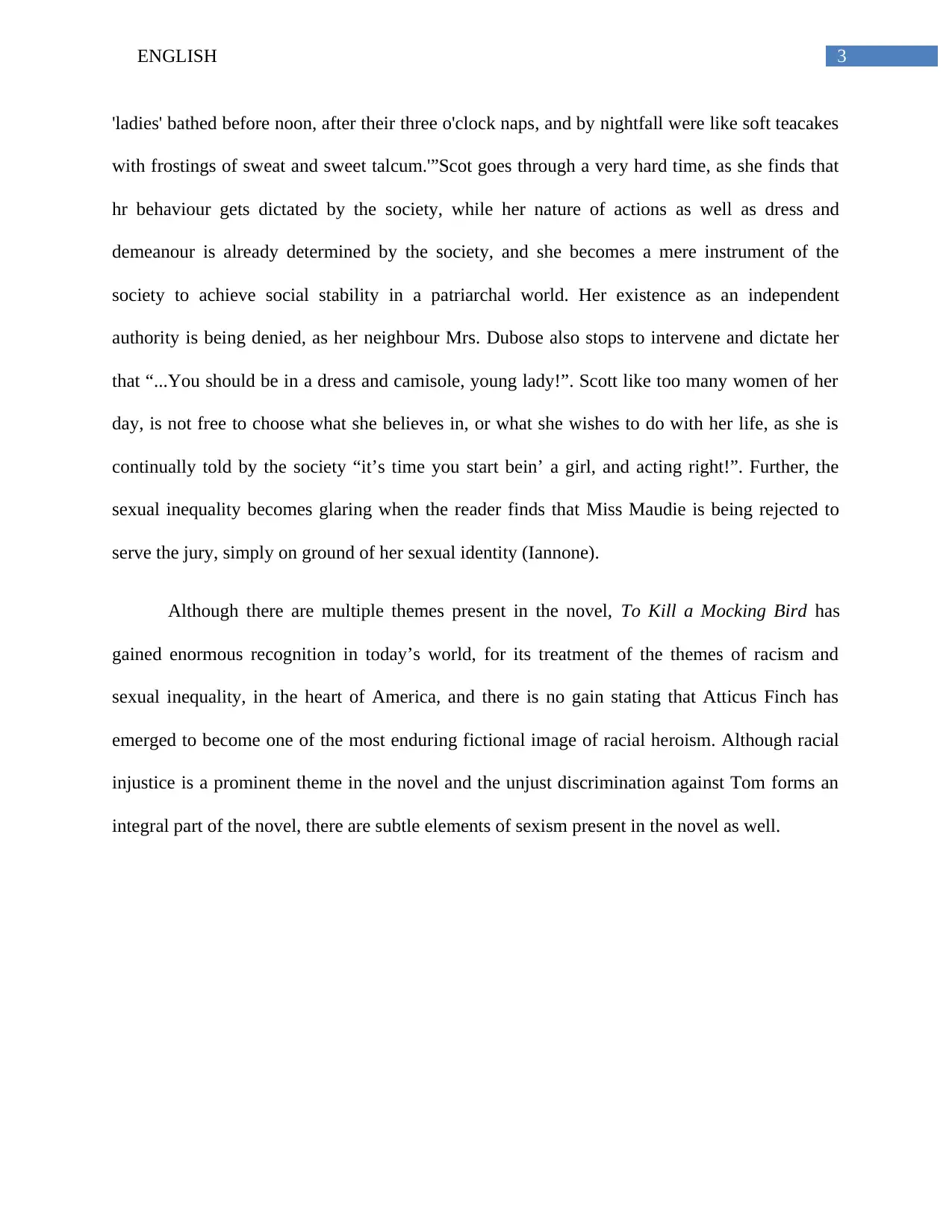
3ENGLISH
'ladies' bathed before noon, after their three o'clock naps, and by nightfall were like soft teacakes
with frostings of sweat and sweet talcum.'”Scot goes through a very hard time, as she finds that
hr behaviour gets dictated by the society, while her nature of actions as well as dress and
demeanour is already determined by the society, and she becomes a mere instrument of the
society to achieve social stability in a patriarchal world. Her existence as an independent
authority is being denied, as her neighbour Mrs. Dubose also stops to intervene and dictate her
that “...You should be in a dress and camisole, young lady!”. Scott like too many women of her
day, is not free to choose what she believes in, or what she wishes to do with her life, as she is
continually told by the society “it’s time you start bein’ a girl, and acting right!”. Further, the
sexual inequality becomes glaring when the reader finds that Miss Maudie is being rejected to
serve the jury, simply on ground of her sexual identity (Iannone).
Although there are multiple themes present in the novel, To Kill a Mocking Bird has
gained enormous recognition in today’s world, for its treatment of the themes of racism and
sexual inequality, in the heart of America, and there is no gain stating that Atticus Finch has
emerged to become one of the most enduring fictional image of racial heroism. Although racial
injustice is a prominent theme in the novel and the unjust discrimination against Tom forms an
integral part of the novel, there are subtle elements of sexism present in the novel as well.
'ladies' bathed before noon, after their three o'clock naps, and by nightfall were like soft teacakes
with frostings of sweat and sweet talcum.'”Scot goes through a very hard time, as she finds that
hr behaviour gets dictated by the society, while her nature of actions as well as dress and
demeanour is already determined by the society, and she becomes a mere instrument of the
society to achieve social stability in a patriarchal world. Her existence as an independent
authority is being denied, as her neighbour Mrs. Dubose also stops to intervene and dictate her
that “...You should be in a dress and camisole, young lady!”. Scott like too many women of her
day, is not free to choose what she believes in, or what she wishes to do with her life, as she is
continually told by the society “it’s time you start bein’ a girl, and acting right!”. Further, the
sexual inequality becomes glaring when the reader finds that Miss Maudie is being rejected to
serve the jury, simply on ground of her sexual identity (Iannone).
Although there are multiple themes present in the novel, To Kill a Mocking Bird has
gained enormous recognition in today’s world, for its treatment of the themes of racism and
sexual inequality, in the heart of America, and there is no gain stating that Atticus Finch has
emerged to become one of the most enduring fictional image of racial heroism. Although racial
injustice is a prominent theme in the novel and the unjust discrimination against Tom forms an
integral part of the novel, there are subtle elements of sexism present in the novel as well.
Paraphrase This Document
Need a fresh take? Get an instant paraphrase of this document with our AI Paraphraser
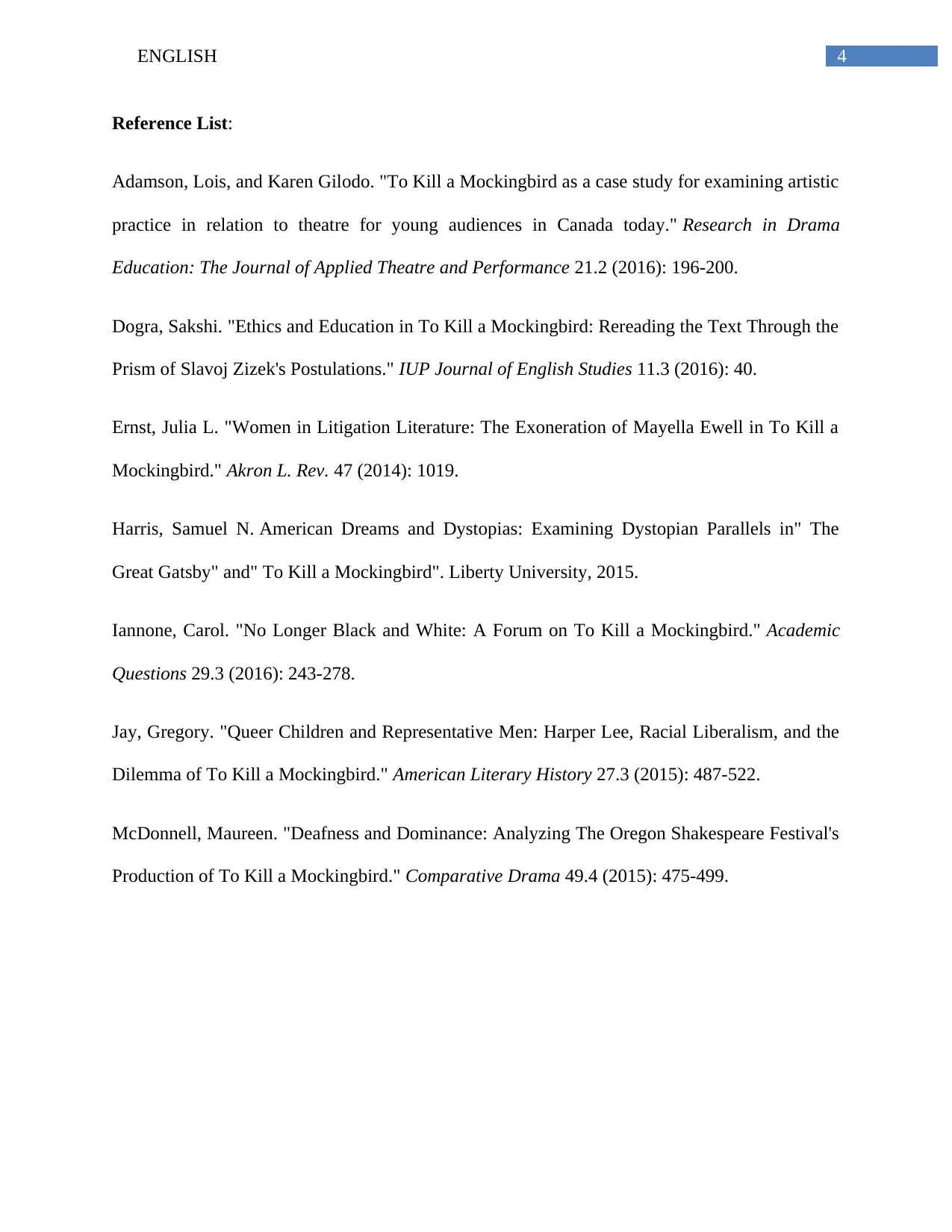
4ENGLISH
Reference List:
Adamson, Lois, and Karen Gilodo. "To Kill a Mockingbird as a case study for examining artistic
practice in relation to theatre for young audiences in Canada today." Research in Drama
Education: The Journal of Applied Theatre and Performance 21.2 (2016): 196-200.
Dogra, Sakshi. "Ethics and Education in To Kill a Mockingbird: Rereading the Text Through the
Prism of Slavoj Zizek's Postulations." IUP Journal of English Studies 11.3 (2016): 40.
Ernst, Julia L. "Women in Litigation Literature: The Exoneration of Mayella Ewell in To Kill a
Mockingbird." Akron L. Rev. 47 (2014): 1019.
Harris, Samuel N. American Dreams and Dystopias: Examining Dystopian Parallels in" The
Great Gatsby" and" To Kill a Mockingbird". Liberty University, 2015.
Iannone, Carol. "No Longer Black and White: A Forum on To Kill a Mockingbird." Academic
Questions 29.3 (2016): 243-278.
Jay, Gregory. "Queer Children and Representative Men: Harper Lee, Racial Liberalism, and the
Dilemma of To Kill a Mockingbird." American Literary History 27.3 (2015): 487-522.
McDonnell, Maureen. "Deafness and Dominance: Analyzing The Oregon Shakespeare Festival's
Production of To Kill a Mockingbird." Comparative Drama 49.4 (2015): 475-499.
Reference List:
Adamson, Lois, and Karen Gilodo. "To Kill a Mockingbird as a case study for examining artistic
practice in relation to theatre for young audiences in Canada today." Research in Drama
Education: The Journal of Applied Theatre and Performance 21.2 (2016): 196-200.
Dogra, Sakshi. "Ethics and Education in To Kill a Mockingbird: Rereading the Text Through the
Prism of Slavoj Zizek's Postulations." IUP Journal of English Studies 11.3 (2016): 40.
Ernst, Julia L. "Women in Litigation Literature: The Exoneration of Mayella Ewell in To Kill a
Mockingbird." Akron L. Rev. 47 (2014): 1019.
Harris, Samuel N. American Dreams and Dystopias: Examining Dystopian Parallels in" The
Great Gatsby" and" To Kill a Mockingbird". Liberty University, 2015.
Iannone, Carol. "No Longer Black and White: A Forum on To Kill a Mockingbird." Academic
Questions 29.3 (2016): 243-278.
Jay, Gregory. "Queer Children and Representative Men: Harper Lee, Racial Liberalism, and the
Dilemma of To Kill a Mockingbird." American Literary History 27.3 (2015): 487-522.
McDonnell, Maureen. "Deafness and Dominance: Analyzing The Oregon Shakespeare Festival's
Production of To Kill a Mockingbird." Comparative Drama 49.4 (2015): 475-499.
1 out of 5
Related Documents
Your All-in-One AI-Powered Toolkit for Academic Success.
+13062052269
info@desklib.com
Available 24*7 on WhatsApp / Email
![[object Object]](/_next/static/media/star-bottom.7253800d.svg)
Unlock your academic potential
Copyright © 2020–2025 A2Z Services. All Rights Reserved. Developed and managed by ZUCOL.



